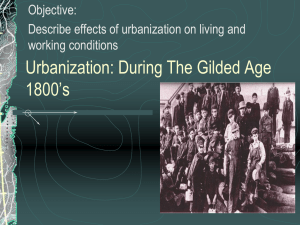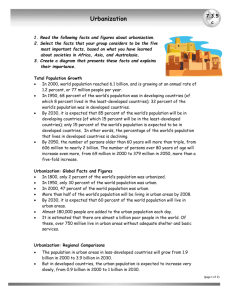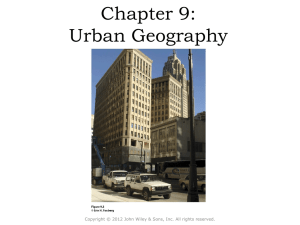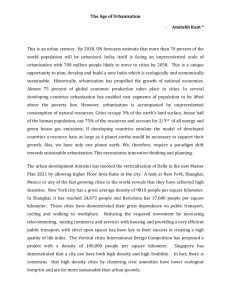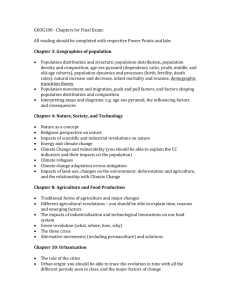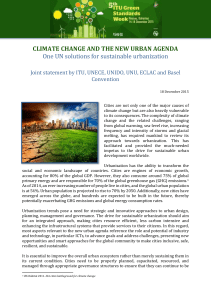Okju Jeong - Global Green Growth Institute
advertisement
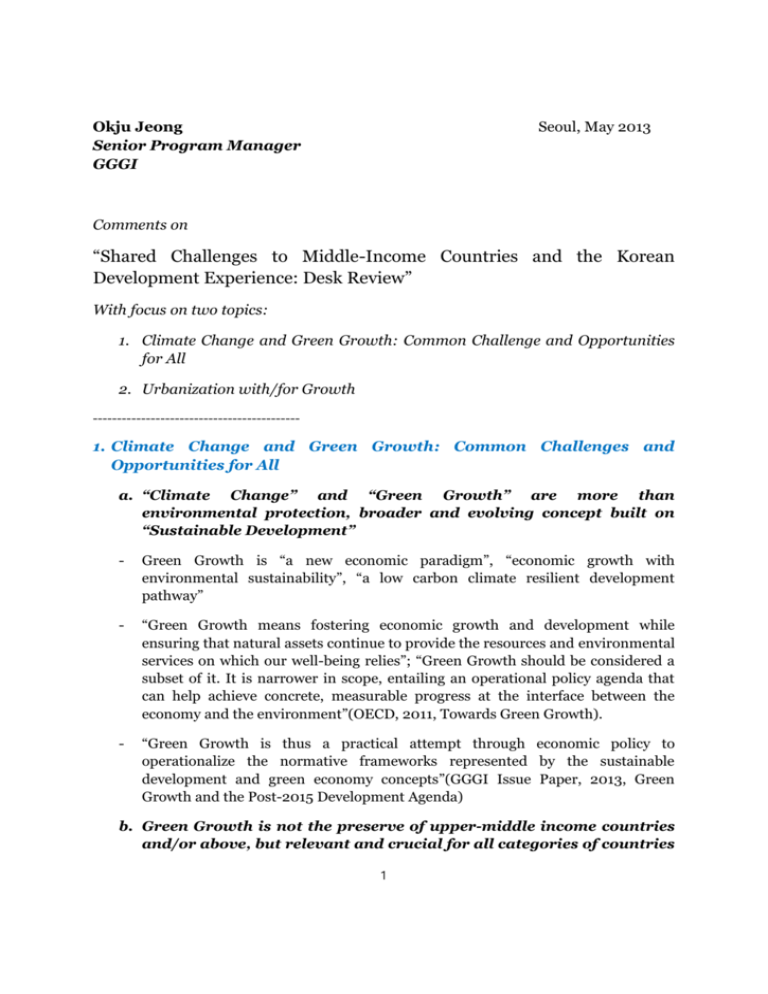
Okju Jeong Senior Program Manager GGGI Seoul, May 2013 Comments on “Shared Challenges to Middle-Income Countries and the Korean Development Experience: Desk Review” With focus on two topics: 1. Climate Change and Green Growth: Common Challenge and Opportunities for All 2. Urbanization with/for Growth ------------------------------------------- 1. Climate Change and Green Growth: Common Challenges and Opportunities for All a. “Climate Change” and “Green Growth” are more than environmental protection, broader and evolving concept built on “Sustainable Development” - Green Growth is “a new economic paradigm”, “economic growth with environmental sustainability”, “a low carbon climate resilient development pathway” - “Green Growth means fostering economic growth and development while ensuring that natural assets continue to provide the resources and environmental services on which our well-being relies”; “Green Growth should be considered a subset of it. It is narrower in scope, entailing an operational policy agenda that can help achieve concrete, measurable progress at the interface between the economy and the environment”(OECD, 2011, Towards Green Growth). - “Green Growth is thus a practical attempt through economic policy to operationalize the normative frameworks represented by the sustainable development and green economy concepts”(GGGI Issue Paper, 2013, Green Growth and the Post-2015 Development Agenda) b. Green Growth is not the preserve of upper-middle income countries and/or above, but relevant and crucial for all categories of countries 1 from underdeveloped to developed countries - Global Green Growth Institute(GGGI) provides analytical and institutional support to more than 20 emerging and developing countries who wish to develop green growth, which are aligned with other national economic goals (28 Projects in 17 Countries & 4 Regions, as of February 2013) - Many emerging and developing countries recognize the importance of climate change; and develop national green growth strategy and its action plan to incorporate climate change programmes and projects for transitioning to a low carbon climate resilient development pathway - Some Examples of national green growth plans National Strategic Plan on Green Growth & National Council on Green Growth (NCGG) in Cambodia (2013) The Cambodian Government developed the National Strategic Plan on Green Growth with a particular focus on efficient use of natural resources, green jobs, green technology, and economic reforms with a strong emphasis on green taxation. Ethiopia’s Vision for a Climate Resilient Green Economy (2011) “Ethiopia did not cause climate change, but we are confronted by the threat that it poses, and should recognize the opportunity that it presents. Climate change is not a future possibility for Ethiopia, it is a present reality. That is why it is imperative that we start now protect our people and our environment, while at the same time building a green economy that will help to realize the ambitions set out in the Growth and Transformation Plan” Vietnam National Green Growth Strategy (2012) “Green Growth, as a means to achieve a low carbon economy and to enrich natural capital, will become the principal direction in sustainable economic development; reduction of greenhouse gas emissions and increased capability to absorb greenhouse gas are gradually becoming compulsory and important indicators in socio-economic development” Kenya’s Climate Change Action Plan: Low Carbon Climate Resilient Development Pathway (2012) “A low carbon climate resilient development pathway, as set out in this Climate Change Action Plan, can help meet Vision 2030 goals through actions that address both sustainable development and climate change. This pathway can also help the government achieve the Millennium Development Goals and other internationally agreed development goals without compromising the environment and its natural 2 resources” Facilitating Green Growth in Africa (AfDB, 2012) “RIO+20 underscored that Green Growth and the transition towards green economy is considered by a growing number of African and developing countries a viable and necessary approach to development. Several African countries have taken the lead in defining their strategic approach to green growth and launching their road maps towards a green economy” “For Africa, the priority is to develop. Promoting green growth in Africa means addressing existing and emerging development challenges without locking countries into development pathways that deplete Africa’s natural capital and leave economies and livelihoods more vulnerable to climate change and other environmental, social and economic risks” 2. Urbanization with/for Growth: More Highlight on the Korean Spatial Policy to influence Demographic and Economic Geography of the Country a. Urbanization matters for growth: Geographic aspects of the demographic transformation have to be more distinctively shed light on, as the demographic transition coincides with a spatial transformation - Cities are the hubs of economic activity accounting for some 70% of global GDP - How to harness urban development for better allocation of limited resources through different spatial and economic measures? The governments try to influence the pace or location of urbanization through a series of spatial policies and plans (Comprehensive National Territorial Plans can be a good example, for Korean case) - Urban diseconomy when cities are not well managed. Corrective measures are required, for example, mitigation of over-concentration in the Capital city and metropolitan cities, promotion of secondary cities as poles of growth across the country b. Urbanization causes growth or growth causes urbanization? - “We know of no countries that either achieved high incomes or rapid growth without substantial urbanization, often quite rapid. There is a robust relationship between urbanization and per capita income: nearly all countries become at least 3 50 percent urbanized before reaching middle-income status, and all high-income countries are 70-80 percent urbanized” (World Bank, 2009, Urbanization and Growth) - Urbanization and growth do not always go together. An increase in the size of the urban population has not necessarily been associated with growth, especially in Africa urbanization, accompanied by very low growth, is concentrating poor people in cities rather than the countryside 4


